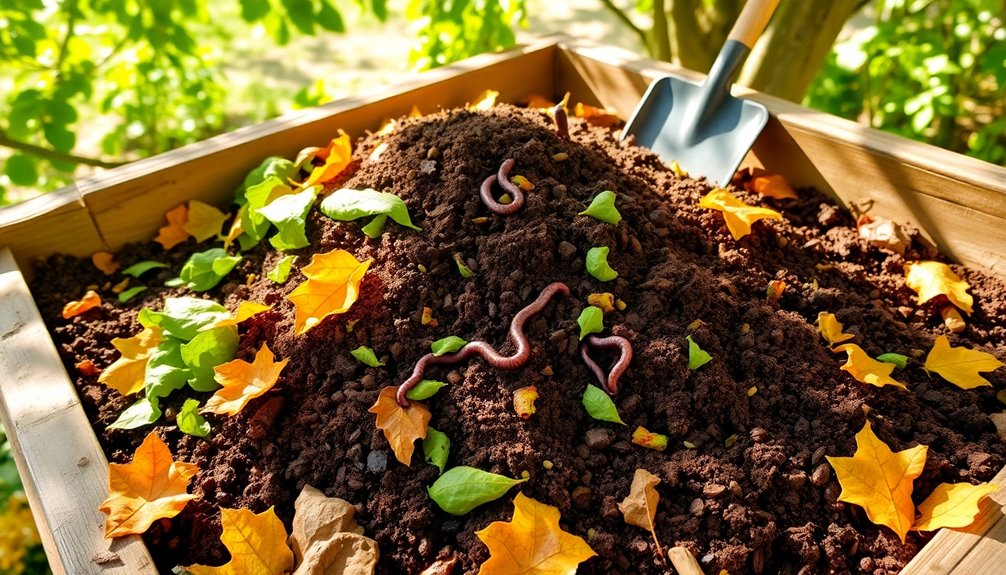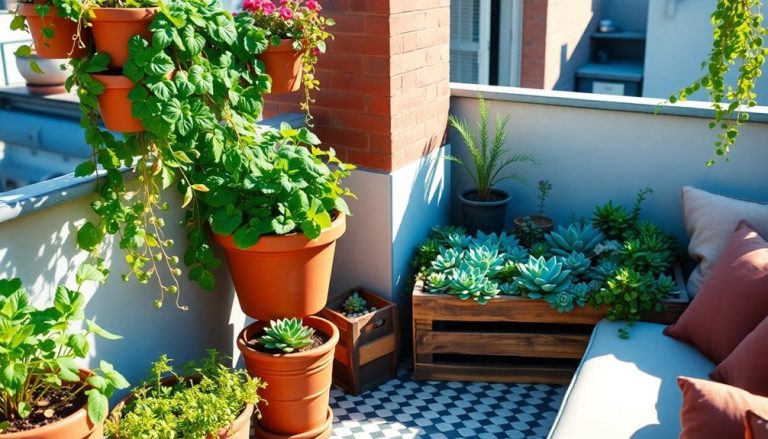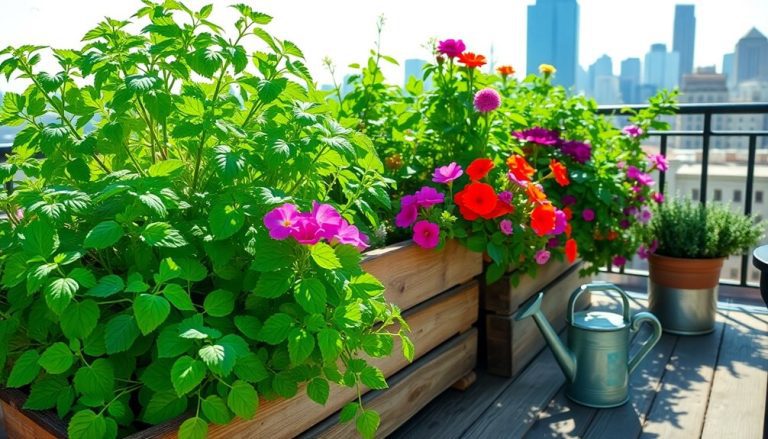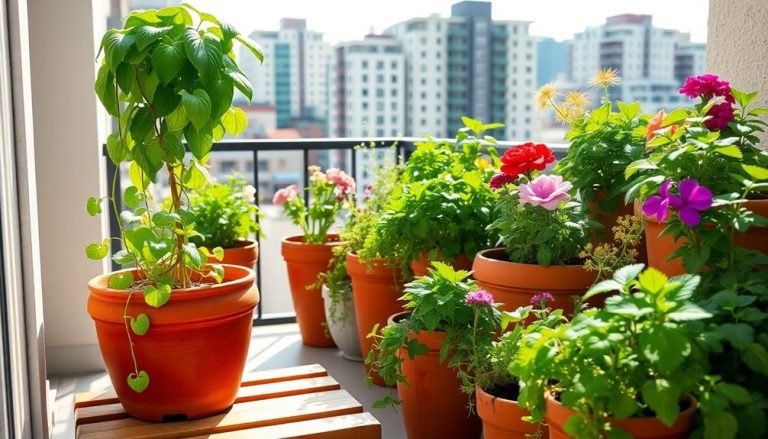To create an effective backyard compost, you'll want to gather a mix of green and brown materials. Start with kitchen scraps like vegetable peels and coffee grounds, which add nitrogen. Next, include yard waste such as grass clippings and dry leaves, rich in carbon. Cardboard, paper, and egg shells are great too. Don't forget about manure—it boosts nutrients significantly! For optimal results, layer in some garden soil or compost activators to introduce beneficial microorganisms. Regularly monitor moisture and turn the pile to speed up decomposition. There's plenty more to explore about composting techniques and tips!
Key Takeaways
- Use kitchen scraps like vegetable peels and coffee grounds as nitrogen-rich green materials to boost decomposition.
- Incorporate brown materials such as dried leaves and cardboard to provide essential carbon for a balanced compost mix.
- Include yard waste like grass clippings and small branches for added nutrients and rapid decomposition.
- Utilize manure from cows or chickens to enhance nutrient content and soil fertility in your compost.
- Layer soil or compost activators to introduce beneficial microorganisms that speed up the decomposition process.
Kitchen Scraps
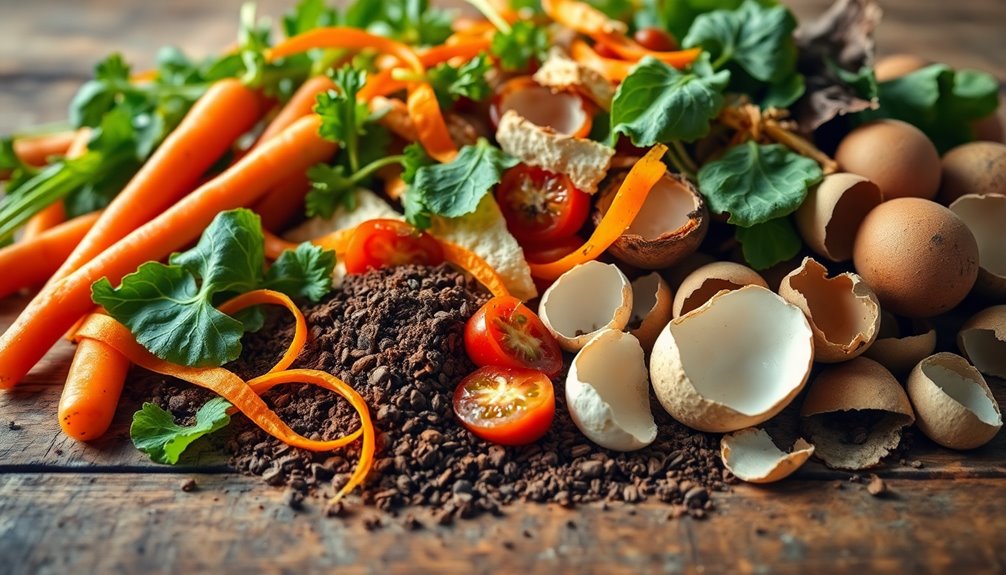
Kitchen scraps are some of the best materials for your backyard compost. They're rich in nitrogen, which helps create a balanced compost mix. You can include vegetable peels, fruit cores, and leftover salad greens. Even coffee grounds and eggshells work wonders, adding valuable nutrients back into the soil. Additionally, using a compost tumbler can enhance the efficiency of your composting process, ensuring that your kitchen scraps break down quickly.
When adding kitchen scraps, remember to avoid certain items. Don't toss in meat, dairy, or oily foods, as they can attract pests and cause odors. Stick to plant-based scraps for the best results.
To keep your compost healthy, chop larger pieces into smaller bits. This speeds up the decomposition process and helps aerate the pile.
You'll also want to maintain a good balance between green materials—like your kitchen scraps—and brown materials, such as dried leaves or shredded cardboard. Aim for a ratio of about 2:1, green to brown. This mix provides the right environment for microorganisms to thrive, breaking down the scraps efficiently. Composting bins can also help optimize the composting process by providing the right conditions for decomposition.
Regularly turning your compost pile ensures proper aeration and faster decomposition. Keep an eye on moisture levels, too; your compost should feel like a damp sponge.
With these tips, you'll turn those kitchen scraps into rich compost in no time!
Yard Waste
In addition to kitchen scraps, yard waste is another fantastic resource for your backyard compost. You can use a variety of materials like grass clippings, leaves, and small branches to enrich your compost pile. These items break down quickly and add essential nutrients to your compost, helping to create a rich, fertile mixture. Incorporating innovative composting solutions can also optimize the efficiency of your composting process.
When gathering yard waste, aim for a mix of soft and hard materials. Grass clippings are nitrogen-rich and decompose rapidly, while leaves provide carbon and structure.
Avoid using large branches or woody materials, as they take longer to break down and can slow the composting process. Instead, use smaller twigs and stems, which decompose more efficiently.
Be mindful of any chemicals used in your yard. If you've treated your lawn or garden with pesticides or herbicides, don't include those clippings in your compost. It's essential to maintain a healthy environment for your composting process. Additionally, incorporating organic mulching materials into your compost can enhance moisture retention and improve overall soil quality.
Brown Materials

While yard waste provides valuable green materials, incorporating brown materials into your compost is equally important for balanced decomposition. Brown materials, rich in carbon, help create the right environment for beneficial microbes to thrive. They're essential for aeration and moisture retention in your compost pile.
Here are some great examples of brown materials you can add:
| Brown Material | Carbon to Nitrogen Ratio | Tips for Use |
|---|---|---|
| Dry leaves | 30:1 | Shred for quicker breakdown |
| Straw or hay | 75:1 | Mix with greens for balance |
| Cardboard | 350:1 | Tear into small pieces |
| Wood chips | 100:1 | Use sparingly, as they break down slowly |
| Pine needles | 80:1 | Acidic; mix with other browns |
When you're adding brown materials, remember to alternate them with green materials to maintain the right balance. This combination not only speeds up decomposition but also produces nutrient-rich compost in no time. Additionally, using high-quality mulch products can further enhance soil structure and moisture retention. So, gather those browns and watch your compost thrive!
Green Materials
Fresh grass clippings, vibrant vegetable scraps, and lively coffee grounds are all excellent examples of green materials that play a crucial role in composting. These materials are rich in nitrogen, which helps speed up the decomposition process and enhances the overall nutrient content of your compost.
By incorporating green materials into your compost pile, you'll create a thriving environment for beneficial microorganisms that break down organic matter.
Here are some other great green materials to consider adding:
- Fruit peels and cores
- Fresh plant trimmings
- Alfalfa meal
- Seaweed
- Manure from herbivorous animals
When you mix these green materials with brown ones—like dried leaves and cardboard—you'll achieve a balanced carbon-to-nitrogen ratio that's essential for healthy composting.
Aim for about two parts brown materials for every part green. Remember to turn your compost regularly to aerate it, which will help speed up the decomposition process.
With the right mix of green materials, you're well on your way to creating rich, nutrient-dense compost that your garden will love. Happy composting!
Coffee Grounds
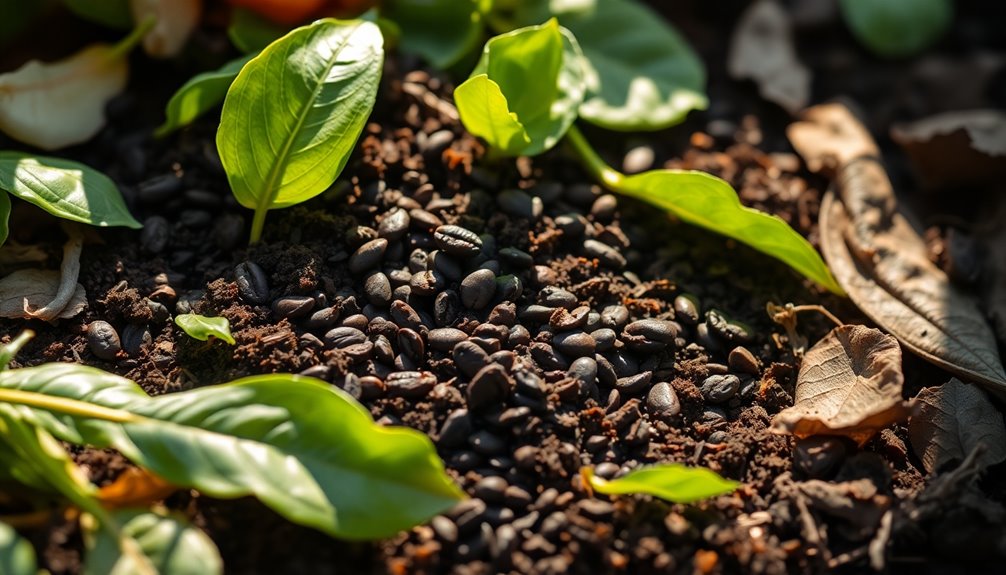
After your morning brew, don't toss those coffee grounds; they're a fantastic addition to your compost pile. Rich in nitrogen, coffee grounds are classified as green materials, which means they'll help balance the carbon content in your compost. Just a small amount can make a big difference in the nutrient profile of your compost.
When adding coffee grounds, mix them in well to avoid clumping. They can retain moisture, so combining them with dry materials like leaves or straw will keep your compost pile aerated and promote decomposition.
Plus, coffee grounds can attract earthworms, which are beneficial for your composting process, helping break down materials more efficiently.
If you're concerned about acidity, rest easy. Coffee grounds are only mildly acidic, and they can actually help neutralize overly alkaline compost.
Just remember to use them in moderation. Too much can lead to a dense pile that's hard to aerate.
Eggshells
Eggshells are a surprisingly valuable addition to your compost pile, offering essential nutrients like calcium that help strengthen plant cell walls. Not only do they improve soil structure, but they also support healthy plant growth. When you toss them into your compost, you're providing a free resource that benefits your garden.
Here are some reasons why you should include eggshells in your compost:
- Calcium Source: They're rich in calcium, crucial for preventing blossom end rot in tomatoes and peppers.
- pH Balancer: Crushed eggshells can help balance soil acidity, promoting a healthier environment for plants.
- Pest Deterrent: Coarsely crushed shells can deter slugs and snails from munching on your plants.
- Aeration Aid: Adding eggshells helps improve soil aeration, enhancing root development.
- Easy to Prepare: Simply rinse, dry, and crush them before adding to your compost.
Incorporating eggshells into your compost is a simple step that yields multiple benefits. So, next time you enjoy a delicious breakfast, don't forget to save those shells for your garden!
Cardboard and Paper
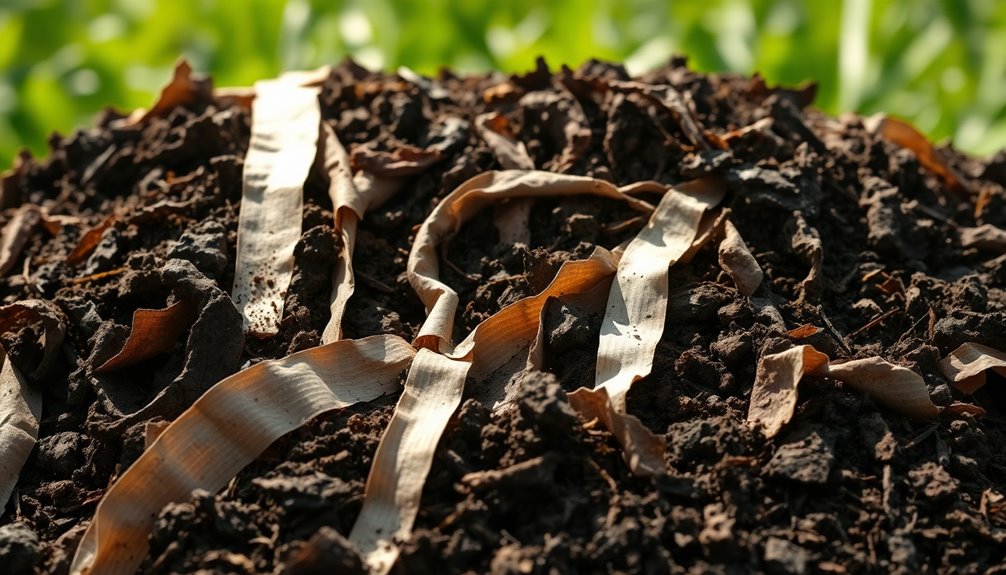
When you're looking for materials to add to your compost, cardboard and paper can be excellent choices. They're rich in carbon, which is crucial for balancing the nitrogen-rich green materials in your compost pile. Just make sure you're using the right types. Plain, uncoated cardboard and paper, like newspapers and office paper, break down easily and provide a good structure for aeration.
Before tossing them in, shred or tear them into smaller pieces. This increases the surface area and speeds up decomposition. Avoid glossy paper or anything with heavy inks, as these can introduce harmful chemicals into your compost. Also, steer clear of cardboard with plastic coatings or tape, as they won't break down properly.
You might worry about odor, but don't fret! When mixed well with other compost materials, cardboard and paper can actually help control smells by absorbing excess moisture.
Just remember to monitor your compost pile's moisture levels, as cardboard can soak up water. By incorporating cardboard and paper into your compost, you're not only reducing waste but also enriching your soil with valuable nutrients.
Happy composting!
Manure
Manure is a powerhouse ingredient for your compost pile, packed with nutrients that help boost soil fertility.
Using manure in your compost not only enriches the mix but also speeds up the decomposition process. When you add it, you're injecting essential nitrogen, which is crucial for healthy plant growth. Just make sure to choose the right type and handle it properly.
Here are five types of manure that work best for composting:
- Cow manure: Rich in nutrients and easy to find.
- Horse manure: Great for adding organic matter and helps aerate the compost.
- Chicken manure: High in nitrogen, but be cautious as it can be "hot" and needs to break down first.
- Rabbit manure: Considered a "cold" manure, it can be added directly without composting first.
- Goat manure: Less odor and great for garden use.
Remember to compost manure thoroughly to kill pathogens and weed seeds.
Mixing it with carbon-rich materials like straw or leaves creates a balanced compost that supports your garden's health.
Soil and Compost Activators

To kickstart your composting process, incorporating soil and compost activators can make a significant difference. These activators are essential for introducing beneficial microorganisms that speed up decomposition. You can use materials like finished compost, aged manure, or even garden soil from your yard to enhance microbial activity.
When you add a layer of soil or compost activator to your compost pile, you're providing a rich source of bacteria and fungi. These tiny organisms break down organic matter, turning kitchen scraps and yard waste into nutrient-rich compost.
Another great option is using commercial compost activators, which often contain a mix of nitrogen, carbon, and microorganisms. Just sprinkle them over your compost pile, and they'll get to work, optimizing the decomposition process.
Be mindful of the balance between green (nitrogen-rich) and brown (carbon-rich) materials in your compost. A good mix will further benefit from activators, ensuring that you create a thriving environment for decomposition.
Frequently Asked Questions
How Often Should I Turn My Compost Pile?
You should turn your compost pile every few weeks to aerate it and speed up decomposition. Regularly mixing helps maintain moisture levels and encourages even breakdown, ensuring rich compost for your garden in less time.
Can I Compost Meat and Dairy Products?
You might think composting meat and dairy could turn your pile into a delightful feast for critters! But it's best to avoid them; they attract pests and create odors that'll make your composting nightmare.
What Is the Ideal Compost Pile Size?
The ideal compost pile size is about three feet wide and three feet tall. This size promotes proper aeration and temperature, helping you break down materials efficiently. You'll notice quicker results with this dimension!
How Long Does Composting Take?
Composting usually takes anywhere from a few weeks to several months, depending on factors like temperature, moisture, and the materials you use. Regularly turning the pile helps speed up the process and achieve quicker results.
How Do I Know When My Compost Is Ready?
Did you know compost can reach temperatures of up to 160°F? You'll know your compost is ready when it's dark, crumbly, and has an earthy smell, usually taking three to six months to mature.
Conclusion
By combining the right materials, you can turn your backyard into a composting powerhouse. Just like a chef mixes ingredients to create a delicious meal, your kitchen scraps, yard waste, and other compostables blend together to enrich your soil. As you layer brown and green materials, coffee grounds, and eggshells, you'll watch your compost thrive. Embrace this natural process, and soon you'll have nutrient-rich compost to nourish your garden, making it flourish like a vibrant tapestry of life.

